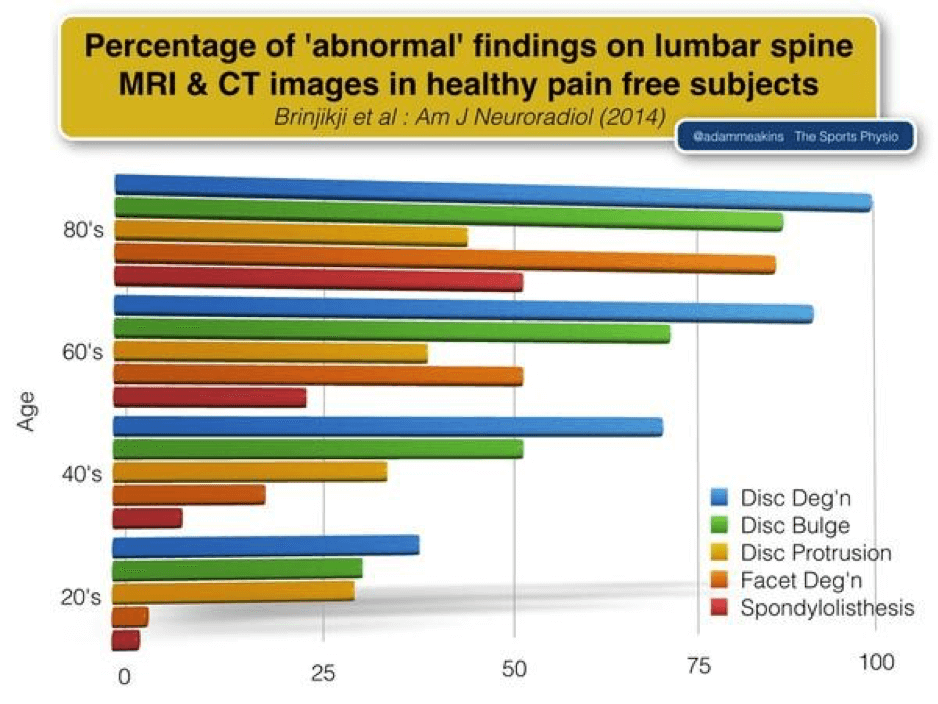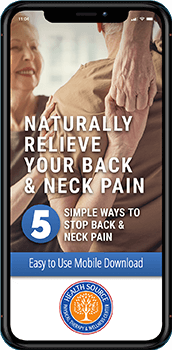Before we move onto busting 5 common beliefs about disc herniations, here are the words of an internationally renowned pain scientist on the idea of a “slipped disc”:
Now, Let’s Bust 5 Myths of Disc Herniations
Myth #1 – the idea that discs can “slip out of place”
Discs are very strong structures that are fortressed by very durable support systems. These support systems include thick tough ligaments that, along with the disc’s resilient and strong covering, make it nearly impossible to “slip a disc”. There are too many structures connected to our discs for such a dramatic displacement to occur.
Discs, however, can get irritated – especially the outer surface. Discs can also bulge in places. Many times these bulges and irritations heal on their own. Other times, they can play a role in the sensation of pain, numbness, tingling, etc. These conditions are something that clinicians at Health Source treat every day.
Myth #2 – an MRI will tell me exactly what is causing my pain
Believe it or not, while MRI’s play a crucial role in emergency situations, they do not do the best job in identifying the cause of back pain. A 2014 study on over 1,200 pain-free healthy adults – aged in their 20’s to 80’s – underwent MRI & CT scans to examine the relationship of disc changes and other degenerative changes over time. The study revealed that things like disc degeneration, disc bulge, disc protrusion, facet degeneration, and spondylolysthesis happen with all individuals as they age. They don’t necessarily correlate with pain symptoms.
Even if an MRI shows some disc injury, it doesn’t mean that surgery is warranted.
Myth #3 – Moving is bad for my back pain
Keeping moving is healthy for your back! The clinicians here at Health Source are skilled in getting the stiff parts of your body moving again so that you do not have to be afraid to move your back. We look at your body through the lens of Mechanics (how are things moving), Neuromuscular Engagement (how efficiently your muscles are working), and Motor Control (coordinating your body so that you can get back to doing what you want to do). This involves hands-on care, education, movement re-training, and individually tailored exercises to help you fully recover.
Myth #4 – I’ll never be able to go back to work, sports, or being myself again
Many of our patients have feared not being able to go back to work, play with their children/grand children, returning to playing sports, or simply being able to use their back. It can also effect how well you sleep. In many cases, it can even effect your mood and how you interact with other important people in your life.
The good news is that with proper care and attention, many of these concerns can be addressed. It requires the right type of treatment, patience, and education. Every one of our patients receive individually tailored treatments to provide the best treatments available, as well as education on how to get better and stay better.
It’s always nice to hear directly from a patient, so check out Laura’s success story on how she overcame her fears surrounding chronic low back pain:
Myth #5 – Surgery is the only option
If you watched Laura’s video, then you know that surgery is avoidable. In many cases, with efficient treatments, many of our clients have been able to avoid unnecessary surgeries.
In fact, here’s a study showing that spontaneous recovery of disc injury can occur, and that disc injury can completely resolve with conservative care. Spontaneous regression occurred at a rate of 96% for disc sequestration, 70% for disc extrusion, 41% for disc protrusion, and 13% for disc bulging. Complete herniation resolved in 43% of sequestered discs and 15% for extruded discs.
The odds are on your side. With proper conservative care, you too can recover from your aches & pains so that you can return to being you.
CONNECT WITH US TO FIND OUT HOW WE CAN HELP YOU
References:
-
Chiu CC e. The probability of spontaneous regression of lumbar herniated disc: a systematic review. – PubMed – NCBI. Ncbinlmnihgov. 2016. Available at: http://www.ncbi.nlm.nih.gov/pubmed/25009200.
-
Brinjikji W e. Systematic literature review of imaging features of spinal degeneration in asymptomatic populations. – PubMed – NCBI. Ncbinlmnihgov. 2016. Available at: http://www.ncbi.nlm.nih.gov/pubmed/25430861.
-
https://thesports.physio/2017/01/10/a-picture-is-not-always-worth-a-thousand-words/
Tags: grand ledge, portland, grand rapids michigan, portland mi, lumbar, low back pain, portland michigan, radiating pain, dewitt michigan, sciatica, disc herniation, slipped disc, grand ledge michigan, surgery, health source physical therapy center, conservative, health source PT, dewitt, lansing michigan, disc, physical therapy




